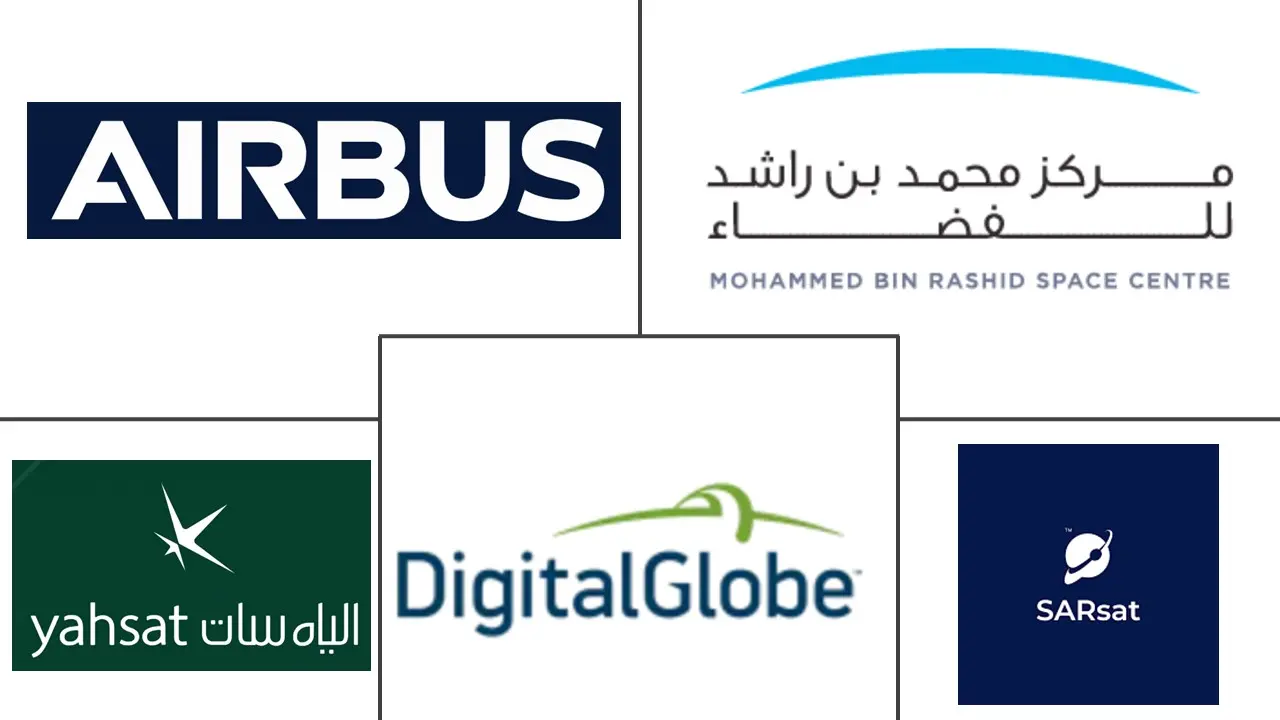Middle East Satellite-based Earth Observation Market Size and Share
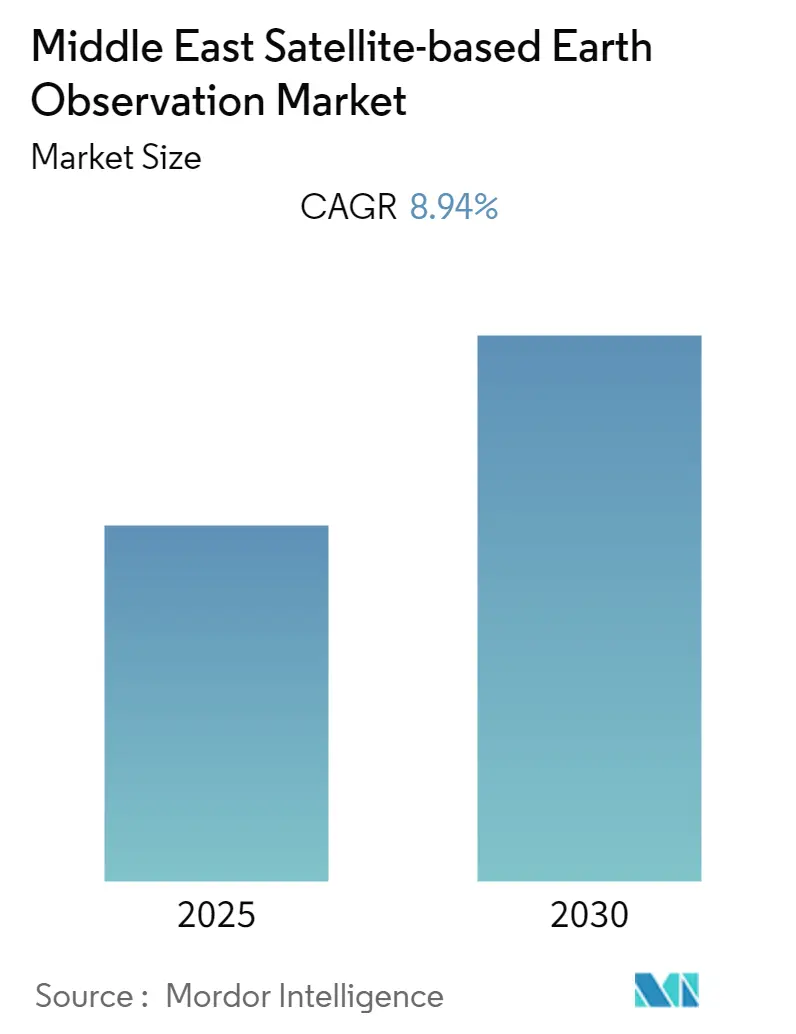
Middle East Satellite-based Earth Observation Market Analysis by Mordor Intelligence
The Middle East Satellite-based Earth Observation Market is expected to register a CAGR of 8.94% during the forecast period.
Remote sensing technology with earth observation is used in many industries to detect and monitor natural phenomena and human activities from a distance using various types of sensors such as optical, radar, and radio frequency. Remote sensing technologies are deemed essential to national capacities, with applications ranging from environmental mapping to urban development to public safety.
- The Middle East region has been investing in satellite-based earth observation services for various reasons, such as environmental monitoring and management, natural resource management, urban planning and development, disaster management, agriculture, and forestry management. These are some of the driving factors behind the growth of satellite-based earth observation services in the Middle East region.
- The growing use of satellites for environmental monitoring is one of the main factors driving the global expansion of the satellite-based earth observation industry. Satellite-based earth observation can be used for various purposes, including monitoring and tracking GHG emissions, deforestation, changes in polar ice, wildfires, and coral bleaching. Recent advancements in sensing and imaging technologies have resulted in the development of superior observation satellites for environmental monitoring. These satellites make it possible to measure numerous indicators and deliver photos with a higher resolution.
- As the region depends on oil exports, disaster management is essential due to the trade; partnerships are forming to minimize the damage and effectively contribute to the market.
- For instance, in June 2023, The Qatari Ministry of Environment & Climate Change received a Synthetic Aperture Radar (SAR*1) satellite-based oil spill detection service, which ITOCHU Corporation and SKY Perfect JSAT Corporation announced. This service, which employs SAR satellite imagery downlinked to KSAT and its partners' ground stations to identify offshore oil leaks, is offered in collaboration with Kongsberg Satellite Services, AS, a global ground network and satellite-based earth observation services provider. Following such a procedure, analysis is carried out in conjunction with data supplied by vessels' AIS (Automatic Identification Systems), allowing the identification of the vessel with the oil leak.
Middle East Satellite-based Earth Observation Market Trends and Insights
Urban Development and Cultural Heritage is analyzed to hold significant share in the market
- Using satellite Earth observation (EO) as a data source can significantly improve data for sustainable urban development. Sustainable urban planning and rural development are gaining ground due to satellite Earth observation (EO), which provides high-resolution satellite imaging data that aids in tracking urban transformation processes. It also has the enormous potential to change urban mobility planning. Users may make more accurate decisions about everything from traffic management to infrastructure development by utilizing the data and insights provided by satellites.
- The growing urban population in the Middle Eastern region, such as UAE, Saudi Arabia, and others, is significantly boosting the demand for the market. For instance, the satellite imagery from DubaiSat-1(UAE satellite) is used for various applications, including infrastructure development, urban planning, and environmental monitoring and protection.
- Further, In Saudi Arabia, urbanization is accelerating quickly. Internal migration and international labor migration are two significant factors that have substantially boosted the populations of metropolitan cities. Jeddah and Riyadh, two Saudi Arabian cities with different histories of industrialization and urbanization, have effects of internal and international labor migration. It contrasts the characteristics of local and immigrant population growth in each city and how that expansion has affected municipal services. The government's response to the expanding urban population and its demand for more municipal services is increasing, thereby contributing to the market.
- Moreover, several projects are being launched in these countries, driving market growth. For instance, The Line, a 170-km-long smart metropolis in the Saudi Arabian desert created by the US design firm Morphosis, has recently gained a lot of attention. Aerial photography company Ot Sky captured images in October 2022 demonstrating the start of construction on this linear city. There is currently space for the subterranean transport system that will run the entire length of the city owing to the huge trench for the foundation being in place. Up to 9 million people will live along The Line. It is anticipated to include a single, 500-meter-tall edifice with a mirrored exterior. The city is anticipated to achieve net zero over its existence.
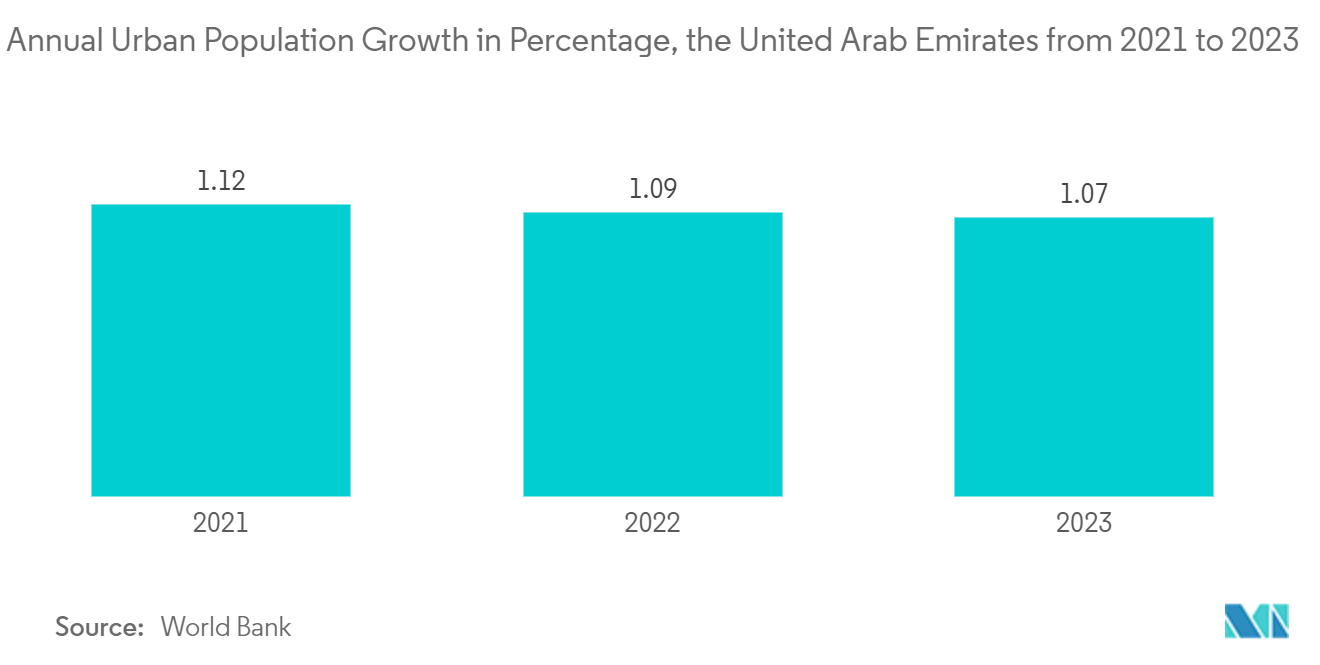
UAE is analyzed to hold largest share in the market
- For the next fifty years, the UAE designated the space sector as one of its key priorities. This was stated by Al Amiri, Minister of State for Public Education and Advanced Technology, at a press conference to announce the launch of the Space Economic Survey 2022, which was developed as part of a strategic partnership between the UAE Space Agency (UAESA) and the Federal Competitiveness and Statistics Centre (FCSC).
- Further, the growing collaborations in the region are analyzed to bolster the market growth rate. For instance, In February 2023, The Mohammed Bin Rashid Space Centre ("MBRSC"), the innovative technological and scientific hub responsible for making the UAE an international player in space services and exploration, and Al Yah Satellite Communications Company PJSC, the UAE's premier satellite solutions provider, have signed a Memorandum of Understanding (MoU) to collaborate together on the commercialization of remote sensing data and earth observation images for Yahsat's commercial and government customers, as well as other projects.
- As part of the agreement, Yahsat will receive earth observation imagery and remote sensing data from MBRSC's fleet of satellites, which will then be made accessible to important clients as a part of Yahsat's extended solutions portfolio through its specifically designated government arm, Yahsat Government Solutions (YGS).
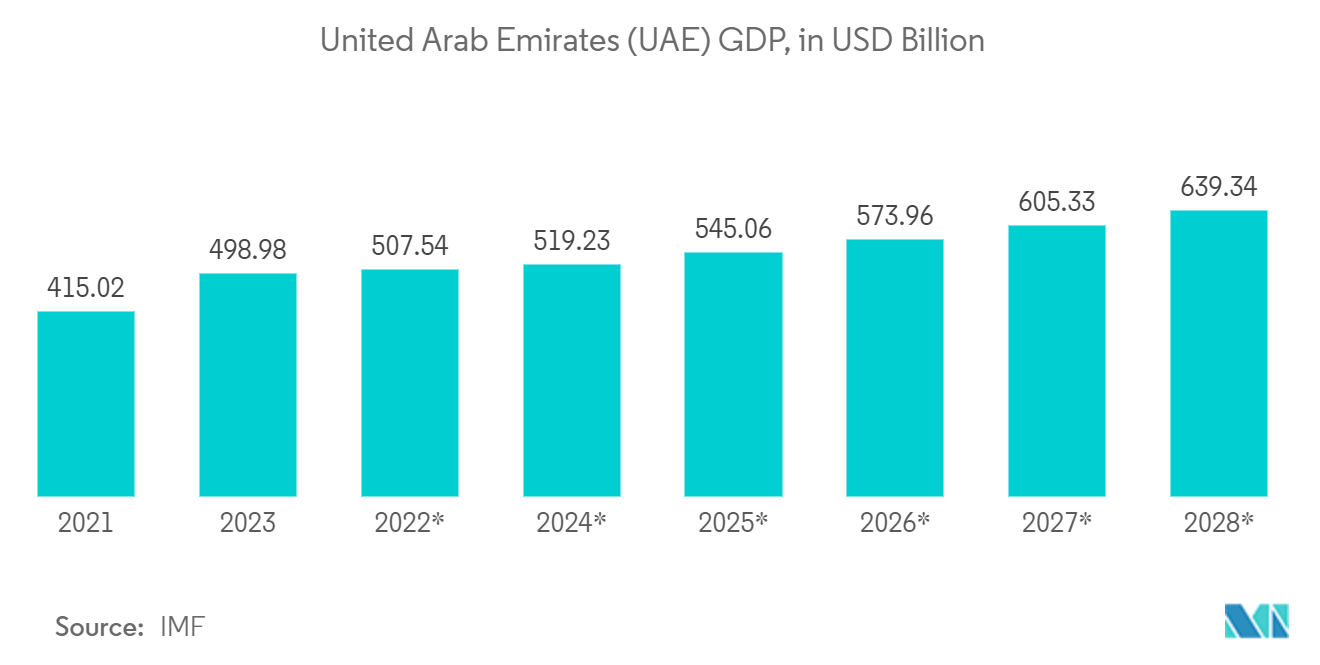
Competitive Landscape
Middle East Satellite-based Earth Observation Market is growing, with the players in the market, such as Al Yah Satellite Communications Company PJSC (Yahsat), Airbus Defense and Space, DigitalGlobe, and SARsat Arabia, making several investments, contributing to the market growth rate.
- April 2023 - King Abdullah University of Science and Technology (KAUST) and its affiliate Spire Global launched a Cubesat satellite on the SpaceX Transporter-7 mission from Vandenberg Space Force Base in the United States. The satellite's mission is to gather high-quality, high-resolution data on terrestrial, coastal, and ocean ecosystems worldwide to assist Saudi Arabia in monitoring and describing its distinctive natural resources.
Middle East Satellite-based Earth Observation Industry Leaders
-
Al Yah Satellite Communications Company PJSC (Yahsat)
-
Airbus Defense and Space
-
DigitalGlobe
-
SARsat Arabia
-
Mohammed Bin Rashid Space Centre (MBRSC)
- *Disclaimer: Major Players sorted in no particular order
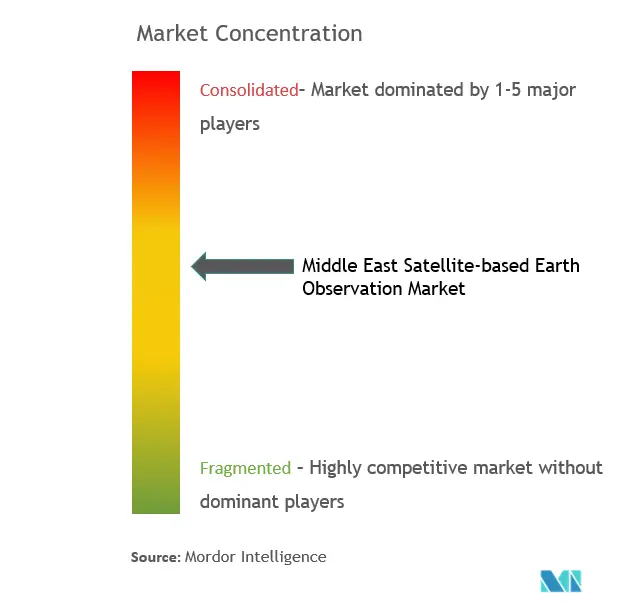
Recent Industry Developments
- August 2024 - Loft Orbital and Marlan Space to create the Middle East’s first private manufacturing space company of commercial satellite constellations for LEO, Orbitworks has secured components for its first 10 satellites, the first of which could be launched as early as the first quarter of 2026. Orbitworks will help Loft Orbital further its vision of flying any payload for any customer in the shortest time to orbit.
- August 2024 - Bayanat AI PLC has announced the successful launch of their first Low Earth Orbit (LEO) Synthetic Aperture Radar (SAR) satellite into orbit on August 16, 2024, in partnership with ICEYE, a pioneer in SAR satellite operations for earth observation, persistent monitoring, and natural catastrophe solutions. In a landmark achievement, the Bayanat-owned SAR satellite, in collaboration with Yahsat, was launched via integrator Exolaunch and successfully lifted off aboard SpaceX’s Transporter 11 rideshare from Vandenberg Space Force Base in California, USA. The satellite has established communication, and early routine operations are underway.
Middle East Satellite-based Earth Observation Market Report Scope
Satellite-based earth observation is done with the help of satellites orbiting around the planet to view and identify environmental changes, map making, etc. The satellite-based earth observation technology captures and stores information from satellites relating to the physical, biological, and chemical compositions of the Earth for monitoring, surveillance, and decision-making in various verticals, such as defense and intelligence, infrastructure and engineering, natural resource management, energy and power, and disaster management.
The Middle East satellite-based earth observation market is segmented by type (earth observation data and value added services), by satellite orbit(low earth orbit, medium earth orbit, and geostationary orbit), and by end-use (urban development and cultural heritage, agriculture, climate services, energy and raw materials, infrastructure, and others) and by country (United Arab Emirates, Saudi Arabia, and others).
The study tracks the key market parameters, underlying growth influencers, and major vendors operating in the industry, which supports the market estimations and growth rates over the forecast period. The market sizes and forecasts are provided in terms of value (USD ) for all the above segments.
| Earth Observation Data |
| Value Added Services |
| Low Earth Orbit |
| Medium Earth Orbit |
| Geostationary Orbit |
| Urban Development and Cultural Heritage |
| Agriculture |
| Climate Services |
| Energy and Raw Materials |
| Infrastructure |
| Others |
| UAE |
| Saudi Arabia |
| Others |
| By Type | Earth Observation Data |
| Value Added Services | |
| By Satellite Orbit | Low Earth Orbit |
| Medium Earth Orbit | |
| Geostationary Orbit | |
| By End-use | Urban Development and Cultural Heritage |
| Agriculture | |
| Climate Services | |
| Energy and Raw Materials | |
| Infrastructure | |
| Others | |
| By Country | UAE |
| Saudi Arabia | |
| Others |
Key Questions Answered in the Report
What is the current Middle East Satellite-based Earth Observation Market size?
The Middle East Satellite-based Earth Observation Market is projected to register a CAGR of 8.94% during the forecast period (2025-2030)
Who are the key players in Middle East Satellite-based Earth Observation Market?
Al Yah Satellite Communications Company PJSC (Yahsat), Airbus Defense and Space, DigitalGlobe, SARsat Arabia and Mohammed Bin Rashid Space Centre (MBRSC) are the major companies operating in the Middle East Satellite-based Earth Observation Market.
What years does this Middle East Satellite-based Earth Observation Market cover?
The report covers the Middle East Satellite-based Earth Observation Market historical market size for years: 2019, 2020, 2021, 2022, 2023 and 2024. The report also forecasts the Middle East Satellite-based Earth Observation Market size for years: 2025, 2026, 2027, 2028, 2029 and 2030.
Page last updated on:
Middle East Satellite-based Earth Observation Market Report
Statistics for the 2025 Middle East Satellite-based Earth Observation market share, size and revenue growth rate, created by Mordor Intelligence™ Industry Reports. Middle East Satellite-based Earth Observation analysis includes a market forecast outlook for 2025 to 2030 and historical overview. Get a sample of this industry analysis as a free report PDF download.
